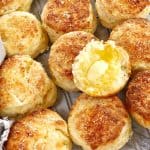
Buttermilk Cheese Scones
Buttermilk Cheese Scones - a super easy recipe for moist savoury scones packed with cheddar cheese and sprinkled with parmesan.
Servings 14
Calories 208kcal
Ingredients
- 450 g self-raising/self-rising flour plus extra for dusting
- 250 ml buttermilk
- 100 g salted butter cold - chopped
- 160 g grated mature cheddar cheese
- ½ teaspoon fine salt
- 2 tablespoon finely grated fresh parmesan cheese
- milk for brushing
Instructions
- Preheat oven to 220c/430f
- Add self-raising flour and chopped butter to a medium-sized bowl. Using your fingertips, rub the butter into the flour (or you can use a pastry cutter like you see in the process photo in the body of this post) until the mixture resembles coarse breadcrumbs.450 g self-raising/self-rising flour, 100 g salted butter
- Add the grated cheddar cheese and salt to the flour mixture and combine using a flat-bladed knife.160 g grated mature cheddar cheese, ½ teaspoon fine salt
- Then add buttermilk and mix to combine, again using a flat-bladed knife. For the final few strokes, I bring the dough together with my hands.250 ml buttermilk
- Turn the dough out onto a lightly floured bench/board and knead the dough very lightly (only a few turns) until just smooth, then pat the dough out into an even disc approximately 2½ cm/1" thick.
- Dip a round 6cm/2½″ scone cutter into some extra flour and cut out scones, being careful not to twist the cutter or touch the edges of the scones (see my notes). Lightly push together any remaining dough and repeat.
- Place scones onto a baking tray, brush the tops with milk and sprinkle parmesan cheese on top then bake for 12 - 15 minutes.milk for brushing, 2 tablespoon finely grated fresh parmesan cheese
Notes
- When you cut out these scones, try not to twist or rotate the cutter at all. If you twist the cutter when pushing down into the dough or when lifting it back out, this will mess up the clean edges you need on your scones to help them rise.
- Likewise, when you are putting them on to the baking tray try not to handle the edges. I use a thin metal cake slice to transfer my raw scones to the tray for baking.
- Try not to knead the leftover dough too much when you are re-rolling the scraps, this will also help with the rise.
- No buttermilk? My go-to substitute is to add 1 tablespoon of white vinegar or fresh lemon juice to 1 cup (250ml) of whole milk, then leave for 5-10 minutes at room temperature until the mixture looks slightly thickened and curdled. Sounds weird but it works! This link has some more alternatives.
- No self-raising flour? For every cup of plain flour (150g) add 2 teaspoon of baking powder and sift together well.
Nutrition
Calories: 208kcal